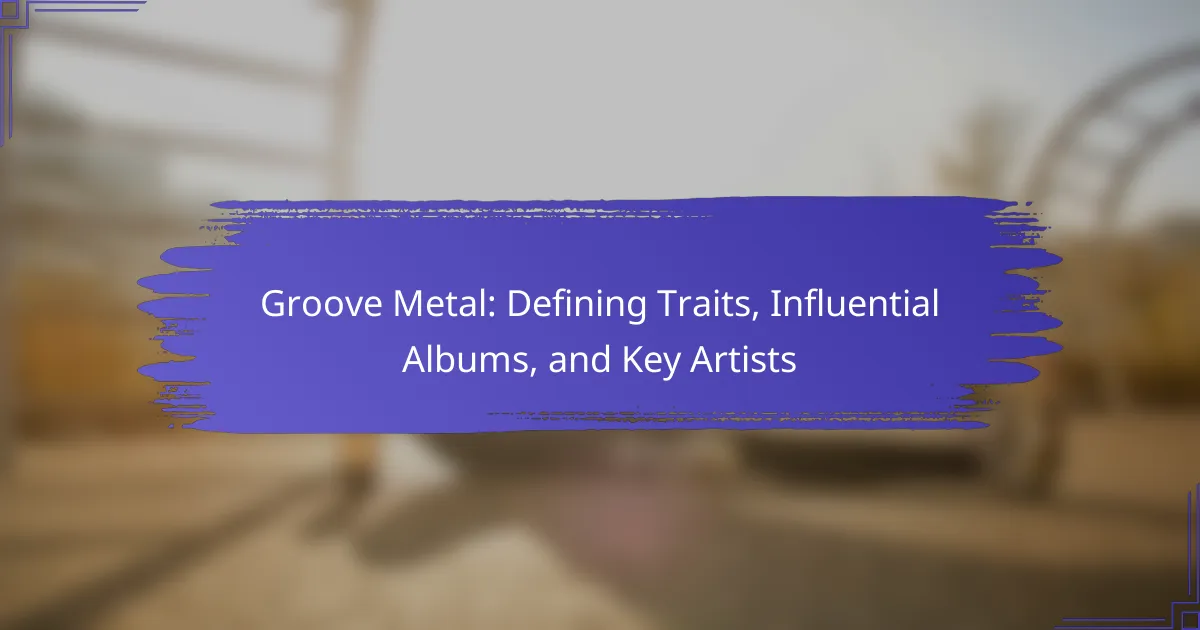Sludge metal offers a unique blend of heavy, distorted guitar riffs and slow tempos, often addressing themes of despair and societal issues. This article explores its sound characteristics, influential groups like Eyehategod and Crowbar, and the cultural context that shaped the genre. Understanding sludge metal reveals its depth, diversity, and commentary on contemporary struggles.
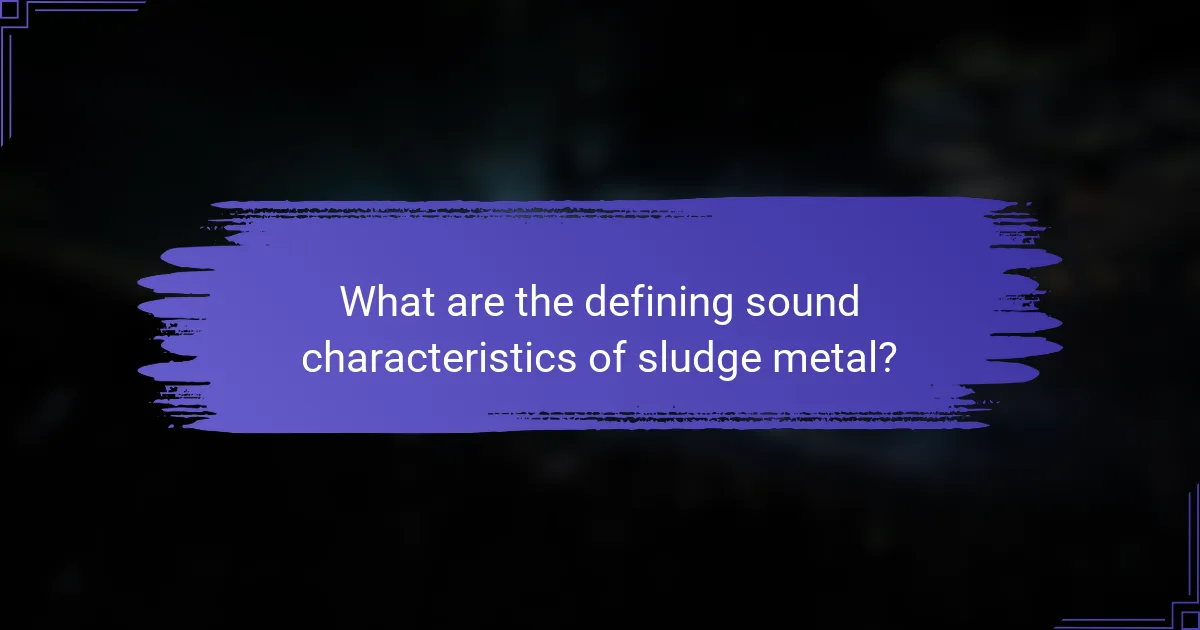
What are the defining sound characteristics of sludge metal?
Sludge metal is characterized by heavy, distorted guitar riffs, slow tempos, and a mix of clean and harsh vocals. The genre often combines elements of doom metal and hardcore punk, creating a dense and oppressive sound.
Key attributes include a focus on atmosphere, with lyrics often exploring themes of despair and existentialism. Influential groups like Eyehategod and Crowbar have shaped its sound, integrating elements of Southern rock and blues. The production quality tends to be raw, enhancing the genre’s gritty aesthetic.
Sludge metal’s unique attribute is its ability to evoke a sense of heaviness both musically and lyrically, making it distinct within the broader metal genre.
How does tempo influence sludge metal’s auditory experience?
Tempo significantly shapes the auditory experience of sludge metal by influencing its heaviness and emotional intensity. Sludge metal typically features slow tempos, creating a dense atmosphere that amplifies feelings of despair and aggression. The drawn-out rhythms allow for extended instrumental passages, which enhance the genre’s characteristic heaviness. Influential bands like Eyehategod and Crowbar utilize tempo variations to create tension and release, effectively engaging listeners. This interplay between tempo and sound texture is essential for the immersive experience that defines sludge metal.
What role do heavy guitar riffs play in creating sludge metal’s atmosphere?
Heavy guitar riffs are essential in creating sludge metal’s dense and oppressive atmosphere. These riffs often feature slow tempos, heavy distortion, and a mix of melodic and dissonant elements. The unique attribute of sludge metal is its ability to evoke a sense of heaviness and despair, largely driven by the guitar work. Influential bands like Sleep and Melvins utilize these riffs to build a sonic landscape that immerses listeners in a bleak emotional state. As a result, the heavy guitar riffs play a pivotal role in defining sludge metal’s distinct sound and cultural impact.
How do vocal styles vary within sludge metal?
Vocal styles in sludge metal vary significantly, characterized by a blend of harsh and melodic elements. Vocals often shift between guttural growls and clean singing, creating dynamic contrasts. Influential bands like Eyehategod and Crowbar exemplify these variations, utilizing different vocal techniques to enhance emotional depth. The unique attribute of sludge metal lies in its ability to convey raw emotion through vocal delivery, often reflecting themes of despair and existentialism.
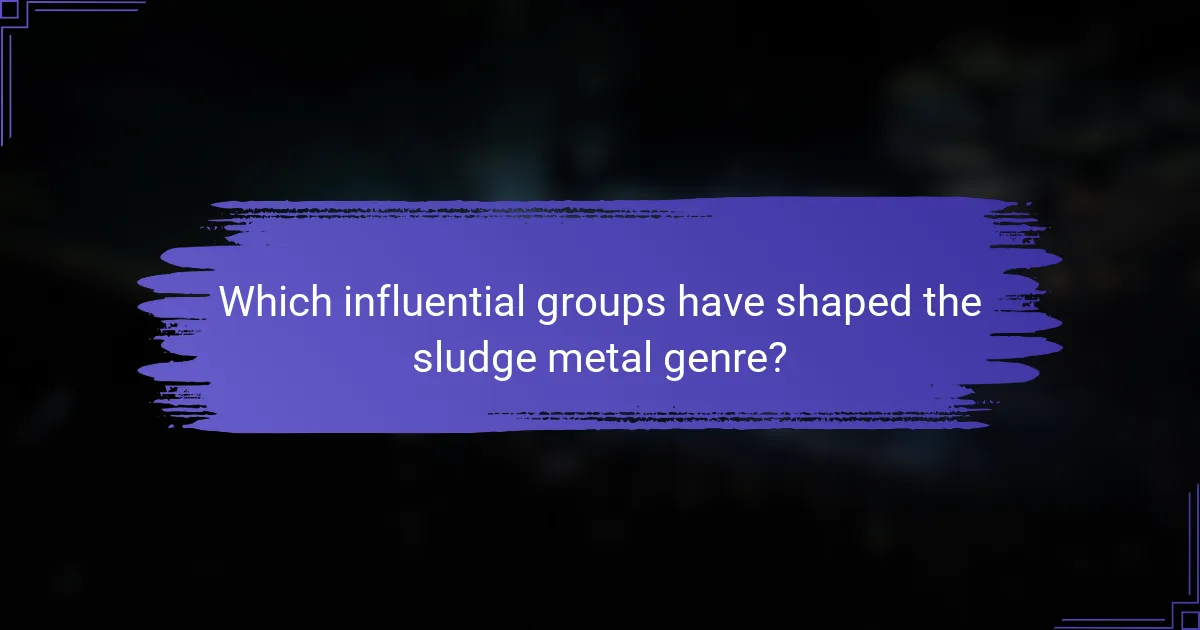
Which influential groups have shaped the sludge metal genre?
The sludge metal genre has been shaped by influential groups such as Eyehategod, Crowbar, and Melvins. These bands are known for their heavy, slow tempos and a blend of various music styles. Eyehategod pioneered the genre with their unique sound, combining elements of doom metal and hardcore punk. Crowbar contributed with their powerful riffs and intense lyrics, while Melvins introduced experimental approaches that expanded the genre’s boundaries. Each group has left a significant mark on sludge metal, influencing countless artists and shaping its cultural context.
What impact did bands like Eyehategod have on sludge metal’s evolution?
Eyehategod significantly influenced sludge metal’s evolution by blending hardcore punk and doom metal, creating a distinct sound. Their heavy, distorted guitar riffs and raw vocal style set a template for future bands. They emphasized themes of despair and addiction, enriching sludge metal’s lyrical depth. Eyehategod’s DIY ethic and live performances helped shape the underground scene, fostering a sense of community among fans and musicians. Their impact is evident in the emergence of bands that adopted similar aesthetics and sounds, solidifying sludge metal as a vital genre.
How did the emergence of Melvins influence sludge metal’s sound?
The emergence of Melvins significantly shaped sludge metal’s sound by introducing slower tempos and heavier guitar riffs. Their experimental approach blended elements of punk and metal, creating a distinct, murky aesthetic. This unique sound influenced numerous bands, establishing a foundation for the genre’s evolution. The Melvins’ use of dynamics and unconventional song structures became hallmark traits in sludge metal, encouraging bands to explore darker themes and heavier tones. Their impact is evident in the works of bands like Eyehategod and Crowbar, who adopted and expanded upon these characteristics.
Which contemporary bands are pushing the boundaries of sludge metal?
Bands like Baroness, Mastodon, and Sleep are currently pushing the boundaries of sludge metal. Their innovative sound blends heavy riffs with melodic elements, expanding the genre’s traditional limits. Baroness incorporates progressive rock influences, while Mastodon explores conceptual storytelling. Sleep revives classic stoner metal aesthetics, adding depth to the sludge experience. Each band contributes unique attributes that redefine sludge metal’s cultural context and sonic landscape.
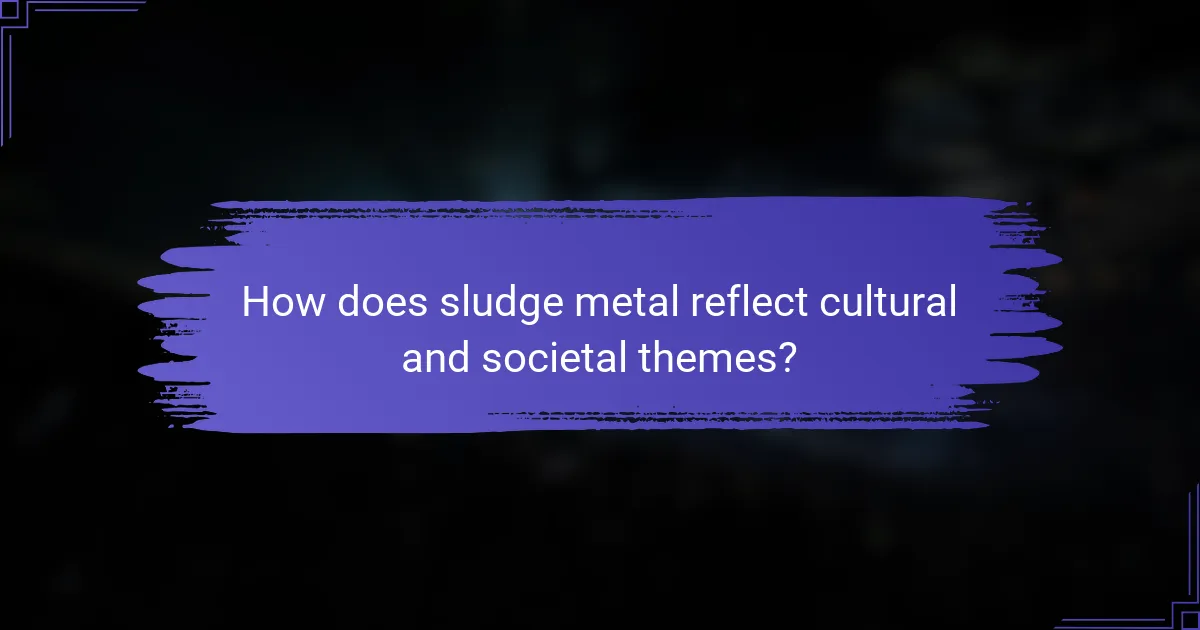
How does sludge metal reflect cultural and societal themes?
Sludge metal reflects cultural and societal themes through its heavy sound and lyrical content, often addressing issues like despair, alienation, and environmental degradation. This genre emerged in the late 1980s, influenced by societal disillusionment and economic struggles.
The slow tempos and distorted guitars evoke a sense of heaviness, mirroring the weight of societal pressures. Bands like Eyehategod and Crowbar explore themes of addiction and personal suffering, resonating with listeners facing similar challenges.
Moreover, sludge metal often incorporates elements from punk and doom metal, creating a fusion that critiques modern life. The rawness of the music serves as an outlet for expressing frustration with societal norms.
In summary, sludge metal’s sound characteristics and thematic content create a powerful commentary on cultural and societal issues, making it a voice for those grappling with contemporary struggles.
In what ways does sludge metal address themes of despair and nihilism?
Sludge metal conveys themes of despair and nihilism through its heavy, slow tempos and harsh vocal styles. The genre often features lyrics that explore feelings of hopelessness, existential dread, and societal disillusionment. Bands like Eyehategod and Crowbar exemplify this with their raw sound and bleak themes. The music’s dense textures create an immersive atmosphere that reinforces the emotional weight of these themes, making listeners confront uncomfortable realities.
How do regional variations influence the lyrical content of sludge metal?
Regional variations significantly shape the lyrical content of sludge metal by reflecting local themes and cultural influences. Lyrics often draw from the socio-political landscape, environmental conditions, and personal experiences unique to each region. For example, Southern sludge metal bands frequently explore themes of decay and struggle, mirroring the socio-economic challenges of the American South. In contrast, European bands may incorporate historical and mythological elements, creating a distinct narrative style. This diversity enriches the genre, showcasing how geographical context influences artistic expression.
What is the relationship between sludge metal and the underground music scene?
Sludge metal significantly influences the underground music scene through its heavy sound and DIY ethos. This genre merges elements of doom metal and hardcore punk, creating a unique auditory experience characterized by slow tempos and thick guitar riffs. Influential bands like Eyehategod and Crowbar have shaped its cultural context, often addressing themes of despair and social issues. The underground scene embraces sludge metal for its authenticity and raw energy, fostering a community that values artistic expression over commercial success.

Which unique attributes differentiate various sludge metal subgenres?
Various sludge metal subgenres are differentiated by their unique attributes such as tempo, vocal style, and lyrical themes. For instance, funeral doom sludge features slower tempos and somber lyrics, while post-metal sludge incorporates atmospheric elements and clean vocals. Additionally, sludgecore blends hardcore punk influences, resulting in aggressive rhythms and politically charged lyrics. Each subgenre’s unique sound and thematic focus contribute to the rich diversity within sludge metal.
How does the incorporation of elements from other genres affect sludge metal?
Incorporating elements from other genres enriches sludge metal by adding complexity and diversity. This genre often blends with doom metal, hardcore punk, and stoner rock, creating a unique sound characterized by heavy riffs and slow tempos. Influential bands like Eyehategod and Crowbar exemplify this fusion, integrating punk’s raw energy and doom’s atmospheric heaviness. As a result, sludge metal evolves, appealing to a broader audience while maintaining its distinct identity.
What are the distinctive features of sludge doom and sludge core?
Sludge doom and sludge core share heavy, slow tempos and thick guitar tones, but differ in lyrical themes and vocal styles. Sludge doom often incorporates dark, atmospheric elements, while sludge core emphasizes aggressive, hardcore influences. Both subgenres reflect a unique blend of heaviness and intensity.
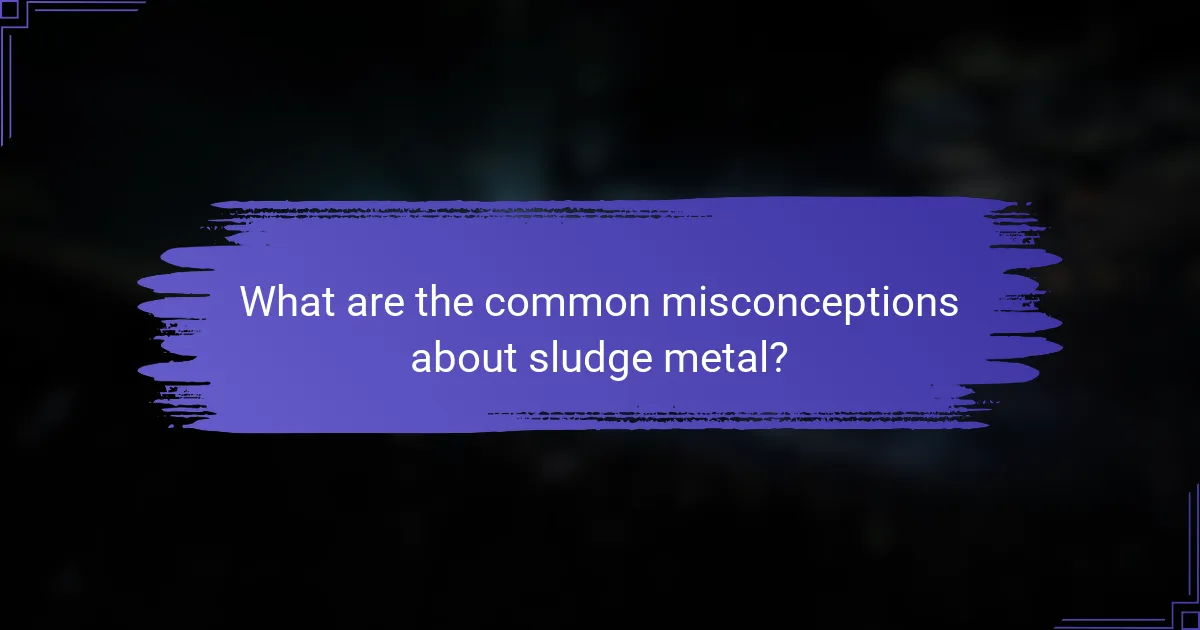
What are the common misconceptions about sludge metal?
Many misconceptions about sludge metal revolve around its sound and cultural significance. One common belief is that it is merely a subgenre of doom metal; however, sludge metal incorporates elements from various genres, including hardcore punk and southern rock. Another misconception is that sludge metal lacks melody. In reality, many sludge bands integrate melodic elements within their heavy soundscapes. Additionally, some people think sludge metal is exclusively dark and nihilistic, while numerous bands explore themes of personal struggle and social issues. Understanding these misconceptions helps appreciate the depth and variety within the sludge metal genre.
Why is sludge metal often misunderstood by mainstream audiences?
Sludge metal is often misunderstood by mainstream audiences due to its complex sound and heavy themes. The genre blends slow tempos, distorted guitars, and harsh vocals, creating a dense auditory experience. This complexity can alienate listeners accustomed to more straightforward musical forms. Additionally, sludge metal’s lyrical focus on despair and existential themes contrasts sharply with popular music’s often upbeat messages. Influential groups like Crowbar and Eyehategod embody these traits, yet their music remains niche, limiting broader appeal. As a result, sludge metal is frequently overlooked in mainstream discussions of heavy music.
How do fans perceive the complexity of sludge metal compared to other genres?
Fans perceive sludge metal as more complex than many other genres due to its layered sound and emotional depth. The genre combines elements of doom metal and hardcore punk, creating a distinct auditory experience. Its slow tempos, heavy riffs, and harsh vocals contribute to a unique atmosphere that fans appreciate. Influential groups like Eyehategod and Crowbar have shaped this complexity, blending various musical influences. Additionally, the cultural context surrounding sludge metal often emphasizes themes of struggle and despair, enhancing its perceived intricacy compared to more straightforward genres.
What are the stereotypes associated with sludge metal musicians and fans?
Stereotypes associated with sludge metal musicians and fans often depict them as heavy, brooding individuals who embrace a darker aesthetic. Fans are perceived as passionate but niche, drawn to the genre’s slow tempos and heavy riffs. Musicians are frequently seen as non-conformists, rejecting mainstream trends. The imagery often includes elements of horror and despair, reinforcing a unique cultural identity. Some view sludge metal enthusiasts as socially isolated, valuing authenticity over popularity.
What best practices can enhance the appreciation of sludge metal?
To enhance the appreciation of sludge metal, focus on immersive listening experiences and community engagement. Attend live performances to feel the genre’s intensity. Explore its roots in doom and hardcore punk for deeper understanding. Share playlists and engage in discussions online to connect with fellow fans. Analyze lyrics and themes to appreciate the emotional depth, fostering a personal connection to the music.


